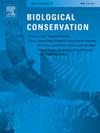Variable social-ecological indicators across a Tanzanian protected area network
IF 4.9
1区 环境科学与生态学
Q1 BIODIVERSITY CONSERVATION
引用次数: 0
Abstract
Protected areas (PAs) represent the most dominant conservation model in the world, though existing research on how and why their conservation outcomes vary remain scarce. In contribution to this discourse, we evaluated the densities and temporal trends of seven herbivorous mammal species across a protected area (PA) network in the Tarangire Ecosystem, Tanzania, and assessed human-wildlife interactions for 19 species. We conducted seasonal wildlife surveys inside five PAs and structured questionnaires in adjacent villages. Our study focused on two national parks, two community-based conservation areas, and one game-controlled area with limited management capacity. We extracted several ecological (wildlife densities and their trends over time) and human-wildlife interaction (number of herbivore and carnivore species associated with benefits, costs and illegal use) indicators and compared them across the PAs using generalized linear models. We found that both national parks and community-based conservation areas can support high densities of mammal species with stable or positive annual trends. In some instances, these wildlife population dynamics were associated with negative human-wildlife interactions near the boundaries of the PA, but this did not emerge as a consistent pattern. National parks can also be associated with negative annual population trends and negative human-wildlife interactions near their boundaries. The game-controlled area scored the lowest on both ecological and human-wildlife interaction indicators highlighting the importance of management-in-practice. Our findings suggest that the outcomes of PAs vary considerably, even within the same ecosystem, and that local social-ecological context likely affects their sustainability.
坦桑尼亚保护区网络的可变社会生态指标
保护区(pa)代表了世界上最主要的保护模式,尽管现有的关于其保护结果如何以及为什么变化的研究仍然很少。在本文中,我们评估了坦桑尼亚Tarangire生态系统保护区(PA)网络中七种食草哺乳动物的密度和时间趋势,并评估了19种人类与野生动物的相互作用。我们在五个保护区内进行了季节性野生动物调查,并在邻近的村庄进行了问卷调查。我们的研究集中在两个国家公园、两个社区保护区和一个管理能力有限的野生动物控制区。我们提取了几个生态指标(野生动物密度及其随时间的变化趋势)和人类与野生动物的相互作用指标(草食动物和食肉动物的数量与利益、成本和非法使用相关),并使用广义线性模型对这些指标进行了比较。我们发现,无论是国家公园还是社区保护区,都能支持哺乳动物物种的高密度,并保持稳定或积极的年趋势。在某些情况下,这些野生动物种群动态与PA边界附近的人类与野生动物的负相互作用有关,但这并不是一个一致的模式。国家公园也可能与负的年度人口趋势和负的人类与野生动物在其边界附近的互动有关。野生动物控制区在生态和人类与野生动物相互作用指标上得分最低,突出了实践管理的重要性。我们的研究结果表明,即使在同一生态系统内,保护区的结果也有很大差异,当地的社会生态背景可能会影响它们的可持续性。
本文章由计算机程序翻译,如有差异,请以英文原文为准。
求助全文
约1分钟内获得全文
求助全文
来源期刊

Biological Conservation
环境科学-环境科学
CiteScore
10.20
自引率
3.40%
发文量
295
审稿时长
61 days
期刊介绍:
Biological Conservation is an international leading journal in the discipline of conservation biology. The journal publishes articles spanning a diverse range of fields that contribute to the biological, sociological, and economic dimensions of conservation and natural resource management. The primary aim of Biological Conservation is the publication of high-quality papers that advance the science and practice of conservation, or which demonstrate the application of conservation principles for natural resource management and policy. Therefore it will be of interest to a broad international readership.
 求助内容:
求助内容: 应助结果提醒方式:
应助结果提醒方式:


